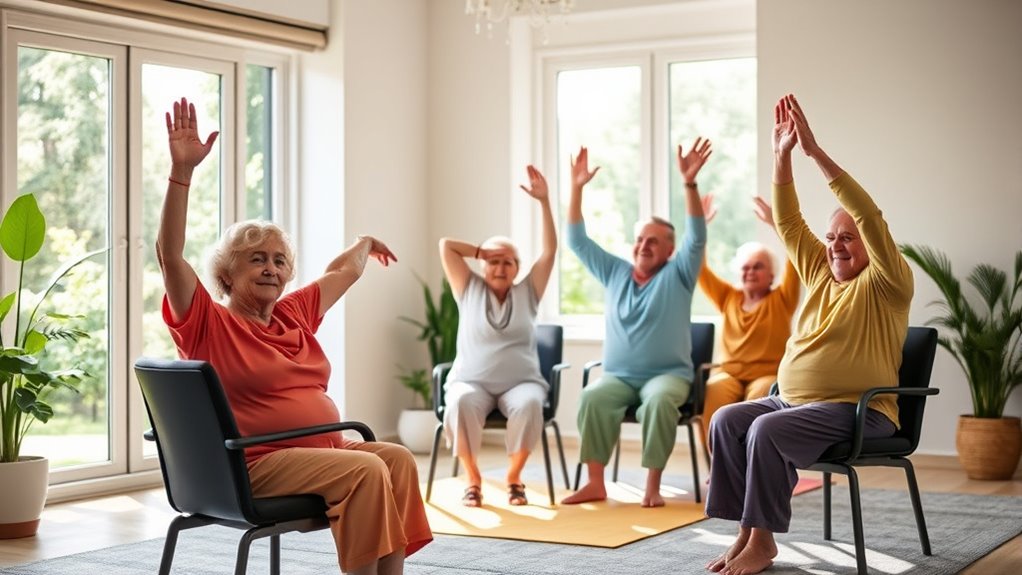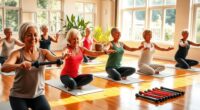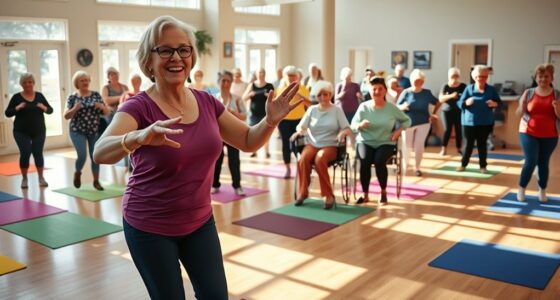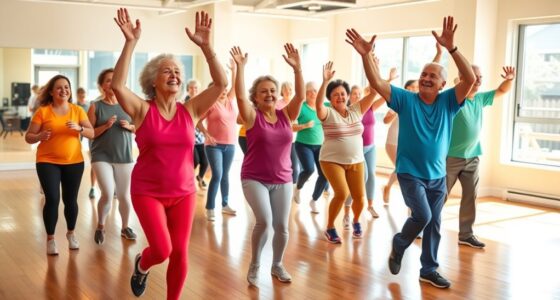Chair yoga is a fantastic way to keep you flexible and strong. It enhances your balance, mobility, and overall well-being while accommodating your needs. You’ll find warm-up exercises, strength training movements, and breathing techniques that make practice enjoyable. Using a sturdy chair, light weights, and focused breathing can improve both physical strength and relaxation. Staying consistent with your routine is key to maximizing benefits. Keep going, and you’ll discover even more effective exercises to enhance your practice.
Key Takeaways
- Engage in gentle warm-up exercises like wrist circles and hip “windshield wipers” to enhance flexibility and blood circulation.
- Incorporate strength training movements such as bicep curls and leg lifts using light weights for safe muscle engagement.
- Utilize seated stretches like forward bends and torso twists to improve spinal mobility and relieve tension.
- Practice deep breathing techniques to boost lung capacity and promote relaxation during yoga sessions.
- Establish a consistent routine with at least 2-3 sessions per week to enhance strength and flexibility over time.
The Benefits of Chair Yoga for Seniors

Chair yoga offers numerous benefits for seniors, especially since it allows you to stay active while seated. By engaging in these gentle stretches and strength exercises, you can enhance flexibility and strength without the risk of falls or injuries. This practice markedly improves your balance and mobility, essential for maintaining your independence as you age. Additionally, chair yoga can help reduce chronic pain, including back pain and arthritis symptoms, promoting your overall well-being. Engaging in these exercises can also lead to better living spaces that support your physical activities and enhance comfort at home. Regular physical activity, such as chair yoga, is crucial for maintaining overall health as you age.
Moreover, studies show that increased smartphone usage among seniors can enhance communication and social engagement, paralleling the benefits of chair yoga in promoting social interaction. The deeper breathing techniques involved also boost lung capacity and oxygen intake, making you feel more vibrant. Beyond physical benefits, participating in chair yoga fosters social interaction and mental stimulation, which can improve cognitive function and emotional health. Moreover, embracing creative practice can further enhance your overall wellness and foster innovative thinking in your daily life.
Embrace chair yoga, and enjoy a healthier, more active lifestyle!
Essential Equipment for Chair Yoga
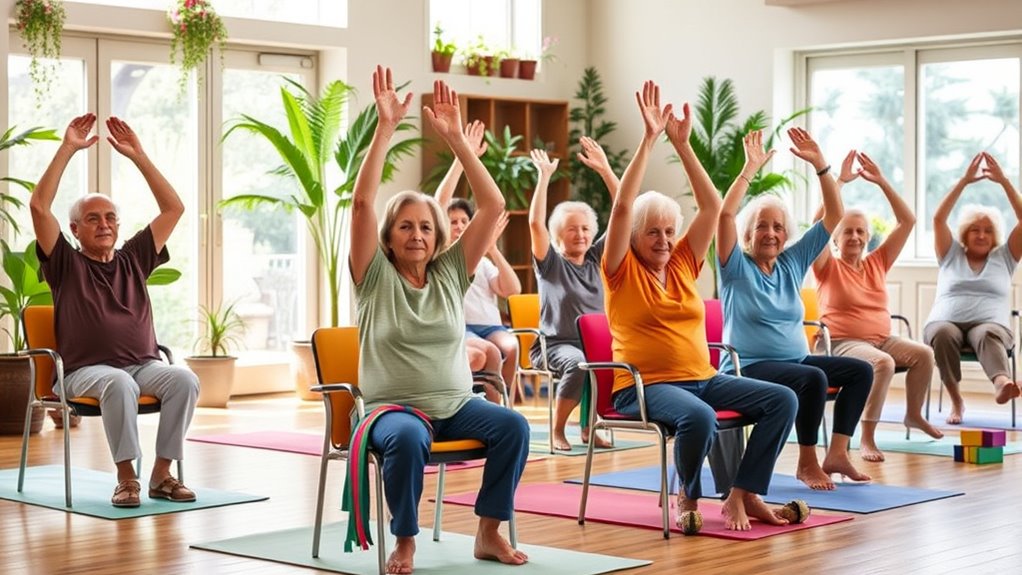
To fully enjoy the benefits of chair yoga, having the right equipment is essential. Start with a sturdy chair without arms to guarantee safety and support during your exercises. This chair will help you maintain stability as you move. Interestingly, freshly squeezed juices can also be a hydrating addition to your routine, ensuring you stay refreshed during practice. Additionally, using a paint sprayer can help you quickly refresh your environment, making it more conducive for yoga.
Consider using a light weight, like a 3-pound dumbbell, to enhance your strength training and effectively build muscle. It’s also important to keep in mind that flexibility exercises are crucial for maintaining mobility as you age. A yoga mat or non-slip surface can provide added comfort and stability, especially during shifts. Don’t forget to wear comfortable clothing that allows for easy movement, assuring a full range of motion. Optional props, such as a yoga strap or small pillow, can also assist with stretches and improve flexibility in various poses, making your chair yoga experience even more enjoyable. Furthermore, incorporating best lifestyle products into your routine can significantly enhance your overall wellness. Additionally, incorporating energy-efficient appliances into your home can create a more comfortable environment for practicing yoga.
Warm-Up Exercises to Prepare the Body
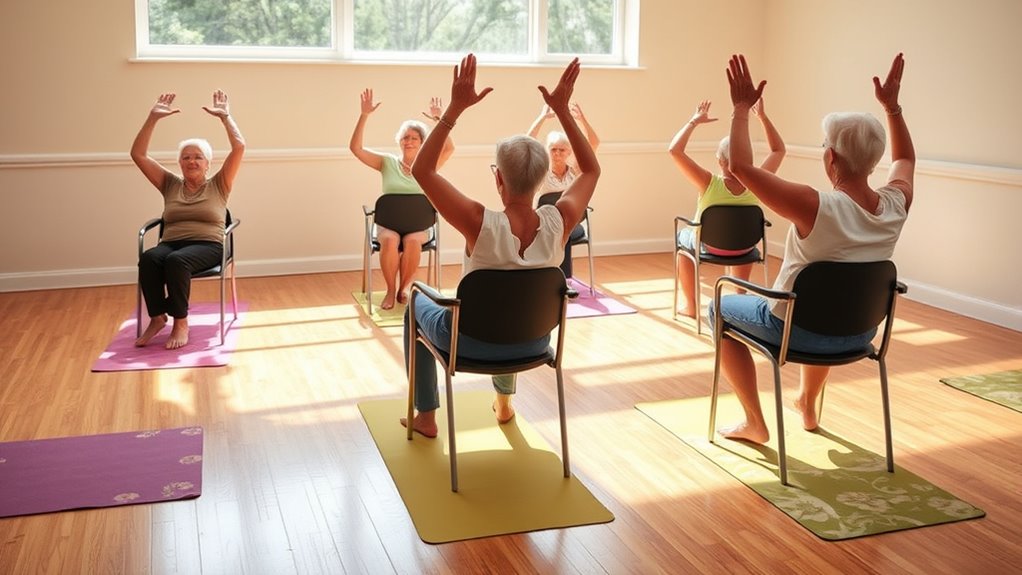
Before you start your chair yoga session, warming up is essential to prepare your body and prevent injury. Simple techniques like deep breathing and gentle movements can effectively increase flexibility and mobility. Engaging in emergency preparedness essentials can also help enhance your overall physical and mental resilience during your practice. Incorporating mood boards into your routine can further inspire a deeper connection to your yoga journey. Additionally, maintaining a balanced budget can alleviate financial stress, which may positively impact your overall well-being during yoga. To enhance your practice, remember that proper hydration and nutrition are key to preventing feelings of fatigue and ensuring your body is ready for movement. Regularly practicing fuel injection cleaning can help improve your physical stamina and support overall wellness, enabling a more fulfilling yoga experience.
Importance of Warm-Ups
Warm-ups play an important role in chair yoga, as they prepare your body for movement and help prevent injuries. Engaging in warm-up exercises enhances blood circulation and increases your range of motion. Incorporating predictive modeling can help tailor warm-up routines to individual needs based on prior experiences and health considerations.
By focusing on core stability, you also protect your lower back during subsequent movements. Incorporating warm-up exercises can improve your overall health by enhancing flexibility and reducing the risk of injury. Additionally, regular warm-ups can promote positive reinforcement in your yoga practice, encouraging a more engaged and motivated mindset.
Consider these key benefits of warm-ups:
- Improved flexibility: Gentle movements like wrist circles and hip “windshield wipers” enhance your mobility.
- Enhanced lung capacity: Deep inhalations with arm raises promote relaxation and set a positive tone for your practice.
- Spinal awareness: Starting with seated forward bends and torso twists stretches your spine, vital for safe chair yoga. Regular warm-ups also support emotional and psychological growth, contributing to a more holistic approach to wellness.
Incorporating warm-ups guarantees a safer and more effective session. Additionally, warm-ups can help reduce stress management techniques that might otherwise hinder your practice.
Basic Warm-Up Techniques
Starting your chair yoga session with basic warm-up techniques sets the tone for a productive practice.
Begin by sitting tall, aligning your knees with your hips to promote stability. Take deep inhalations while raising your arms overhead to open your chest and engage your core.
Now, gently bend forward slightly to stretch your back, alleviating tension and improving flexibility.
Next, you’re going to alternate leg movements using a “windshield wiper” motion to enhance hip mobility. Engaging in activities that focus on motor skills development can also enhance your overall coordination.
Finally, include wrist circles to prepare your arms for strength training movements.
These warm-ups not only increase muscle mass but also make certain your body is ready for more challenging exercises, making your practice safer and more effective. Incorporating educational toys into physical activities can also enhance motor skills and coordination.
Strength Training Movements for Arm and Shoulder Strength

Strength training movements are essential for seniors looking to enhance arm and shoulder strength while minimizing injury risk. Incorporating light weights, like 3-pound dumbbells, helps you stay active without overexerting yourself.
Here are some effective exercises to contemplate:
- Bicep curls: Keep your arms straight and engage your core to protect your lower back.
- Lateral raises: Raise your arms to shoulder height while maintaining high elbow positions for upper back engagement.
- Tricep kickbacks: Focus on controlled movements to build strength in your arms and shoulders.
These exercises promote muscle development and improve overall upper body mobility.
Engaging Leg and Hip Movements
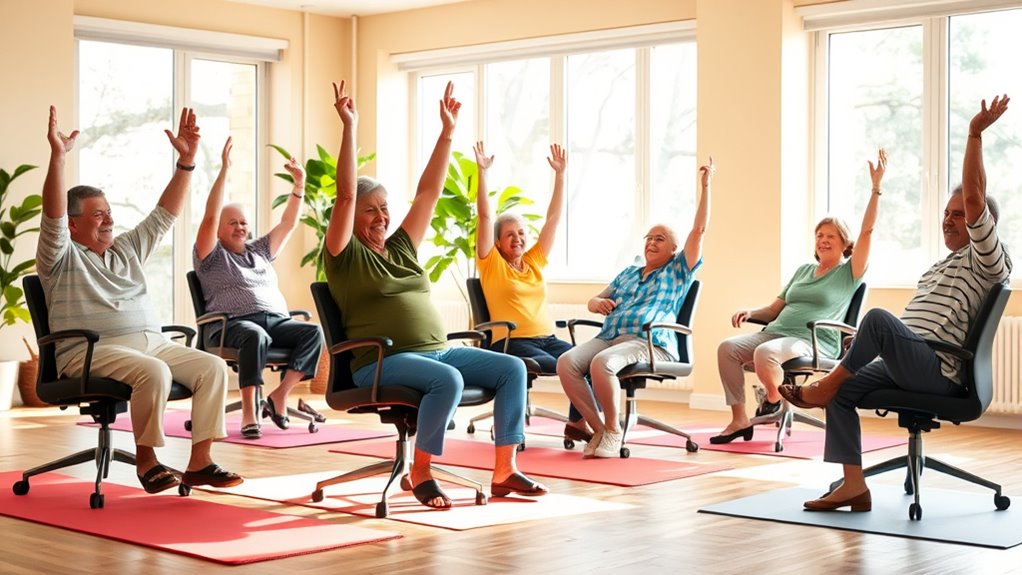
Engaging in leg lifts is a great way to strengthen your glutes and hips, helping you build stability in your lower body.
You’ll also benefit from the figure four position, which stretches your hips while promoting a neutral spine.
Together, these movements can enhance your overall balance and mobility, making daily activities easier.
Benefits of Leg Lifts
While you may not think of leg lifts as a simple exercise, they offer significant benefits for seniors looking to enhance mobility and balance. By incorporating leg lifts into your routine, you’re not only strengthening your hip flexors and glutes but also protecting your lower back.
Keeping your back straight with knees bent at a 90-degree angle is key. Here are some benefits of leg lifts:
- Strengthens hip and thigh muscles, reducing fall risk.
- Improves joint flexibility and overall functional movement.
- Enhances muscle endurance and stability.
Regularly engaging in leg lifts will help you maintain your independence and confidence in daily activities.
Figure Four Position
Incorporating leg lifts into your routine sets the stage for exploring the figure four position, a fantastic way to enhance hip flexibility and relieve tension in your lower back.
To perform the figure four stretch, sit tall and cross one ankle over the opposite knee. While maintaining a neutral spine, gently press down on the knee of the crossed leg to deepen the stretch without straining.
This position not only boosts hip mobility but also engages your core, promoting stability and balance. Hold the figure four position for 20 to 30 seconds on each side to improve flexibility in your hips and legs.
Adding this stretch to your chair yoga routine can help prevent stiffness from prolonged sitting.
Effective Stretching Techniques for Muscle Relaxation

Effective stretching techniques can greatly enhance muscle relaxation, especially for seniors seeking to improve their flexibility and comfort.
Effective stretching techniques can significantly promote relaxation and flexibility, especially for seniors looking to enhance their comfort.
Incorporating a few simple stretches can help you release tension and feel more at ease:
- Gentle forward folds: These target your back and hamstrings while seated, promoting flexibility.
- Torso twists: Seated twists enhance spine mobility and aid in overall muscle relaxation.
- Deep inhalations: Pairing your stretches with deep breaths can improve relaxation and help release muscle tension.
Additionally, don’t forget to include wrist circles and neck stretches, like ear drops towards your shoulders.
Conclude your routine with gentle arm, shoulder, and leg stretches, along with the prayer position for your wrists, providing an extensive approach to relaxation.
Breathing Exercises for Enhanced Relaxation
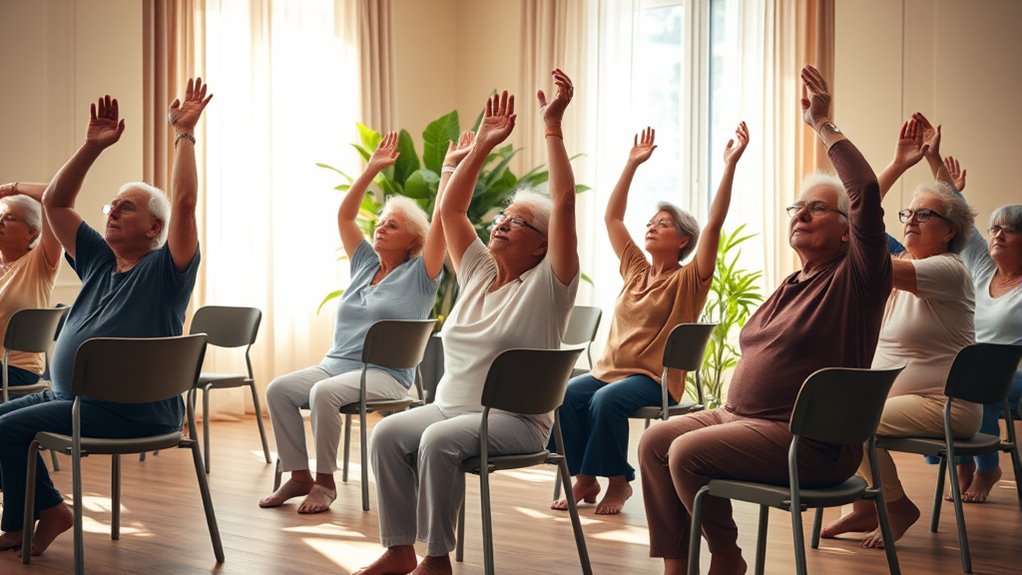
After focusing on effective stretching techniques, it’s time to explore how breathing exercises can further enhance relaxation. Engaging in slow and controlled breathing helps lower your heart rate and reduce stress levels. Practice diaphragmatic breathing to improve lung capacity and oxygen intake. Try synchronizing your breath with movements—raise your arms overhead as you inhale, lower them as you exhale. This mindfulness boosts the benefits of each exercise. Regularly practicing these breathing exercises not only promotes calmness but also aids muscle recovery and enhances mental clarity.
| Breath Technique | Action | Benefits |
|---|---|---|
| Diaphragmatic Breathing | Expand abdomen | Improves oxygen intake |
| Synchronized Breathing | Inhale with movement | Increases mindfulness |
| Deep Breaths | Slow exhale | Activates relaxation |
| Abdominal Breathing | Focus on abdomen | Strengthens lung capacity |
| Mindful Breathing | Count breaths | Enhances cognitive function |
Neck and Shoulder Stretches for Tension Relief

To ease tension in your neck and shoulders, try some gentle neck stretches and shoulder roll techniques.
These simple movements can considerably improve your mobility and reduce discomfort from sitting.
Pair these stretches with deep breathing exercises to maximize relaxation and enhance your overall well-being.
Gentle Neck Stretches
Gentle neck stretches can greatly reduce tension in your neck and shoulders, especially if you often feel stiff from aging or a sedentary lifestyle.
Here are a few simple stretches you can try:
- Ear to Shoulder: Drop your ear towards your shoulder and hold for a few breaths, then switch sides. This promotes flexibility and blood flow.
- Chin Drops: Lower your chin towards your chest to stretch the back of your neck and improve posture.
- Wrist Circles: While pressing your palms together, make wrist circles to release tension in your arms and shoulders, enhancing overall upper body flexibility.
Shoulder Roll Techniques
Neck stretches can set the stage for more extensive relief, and shoulder rolls are a fantastic way to ease tension in your neck and shoulders. To perform shoulder rolls, start by leaning forward slightly, keeping your palms facing down on your thighs.
| Direction | Steps | Repetitions |
|---|---|---|
| Forward | Raise your shoulders towards your ears, roll them forward, and drop them down. | 5-10 |
| Backward | Lift your shoulders towards your ears, roll them back, and let them drop. | 5-10 |
This gentle routine improves circulation and flexibility in your shoulder joints. Remember to perform shoulder rolls in both directions for balanced muscle engagement, promoting relaxation and relieving discomfort in your neck and shoulders.
Deep Breathing Exercises
While incorporating deep breathing exercises into your routine, you’ll find that they greatly enhance relaxation and ease tension in your neck and shoulders.
Start by practicing these techniques, making sure to breathe in deeply and exhale nice and slow:
- Neck Stretch: Drop your ear towards your shoulder to alleviate stiffness and improve cervical mobility.
- Shoulder Rolls: Engage in gentle shoulder rolls while inhaling and exhaling to release tension in your upper back.
- Wrist Circles: Press your palms together and perform wrist circles, which help improve joint mobility and relieve arm tension.
Creating a Mindful Chair Yoga Routine

Creating a mindful chair yoga routine can greatly enhance your physical and mental well-being. Start by sitting tall, aligning your knees with your hips to promote spinal alignment. Incorporate deep breathing exercises throughout your practice; they help release tension and make each pose more effective.
Begin with gentle warm-ups like wrist circles and torso twists to increase flexibility and prepare your muscles. Next, integrate strength training movements, such as bicep curls and tricep kickbacks, while keeping your core engaged for lower back support.
Conclude your routine with calming stretches and deep breathing, reinforcing relaxation and mindfulness. This holistic approach not only strengthens your body but also nurtures your mind, ensuring a thorough yoga experience.
Tips for Staying Consistent With Chair Yoga Practice

To stay consistent with your chair yoga practice, establishing a regular schedule is key. Aim for at least 2-3 sessions a week to create a consistent routine that builds flexibility and strength.
Here are some tips to help you maintain your practice:
- Start with short sessions of 10-15 minutes, increasing duration as your comfort grows.
- Designate a dedicated space for practice, free from distractions to enhance focus.
- Incorporate a variety of exercises, including warm-ups, strength training, and stretching to keep things interesting.
You might also consider joining a chair yoga class or online community for added support and motivation.
This way, you’ll find accountability and encouragement, making your practice more enjoyable and sustainable.
Frequently Asked Questions
Does Chair Yoga Really Work for Seniors?
Yes, chair yoga really works for seniors!
You’ll find that it improves flexibility and balance, helping reduce the risk of falls. It strengthens your muscles, especially in your upper body and core, while being gentle enough for those with limited mobility.
Plus, practicing chair yoga promotes relaxation and mental well-being, making it a great way to enhance your quality of life.
How Often Should Seniors Do Chair Yoga?
You should aim to practice chair yoga at least 2 to 3 times a week.
This frequency helps maintain your flexibility and strength effectively. Each session can last 20 to 30 minutes, greatly enhancing your overall well-being.
Regular practice improves balance, mobility, and joint health while reducing stiffness. Plus, it promotes mental clarity and reduces stress, making your daily activities easier and more enjoyable.
Consistency is key for the best results!
Can You Lose Weight Doing Chair Yoga for Seniors?
Think of chair yoga as a gentle stream, flowing steadily toward weight loss.
While it mightn’t be a raging river, you can still shed pounds by incorporating these movements into your routine.
Chair yoga promotes physical activity, boosts metabolism, and builds muscle tone, which helps your body burn calories more efficiently.
Plus, it encourages mindfulness, leading to healthier eating habits.
Does Chair Yoga Help With Flexibility?
Yes, chair yoga can definitely help with flexibility.
By incorporating gentle stretches and dynamic movements, you can target major muscle groups and improve your range of motion. Regular practice encourages spinal flexibility and reduces stiffness, making it easier for you to move comfortably.
Plus, since you’re seated, it’s a safe way to engage in exercises that might be challenging otherwise, allowing you to enhance your overall body coordination and balance with confidence.
Conclusion
As you embrace chair yoga, think of yourself as a sturdy tree, rooting deeper with every practice while reaching for the sky. Each stretch and breath nurtures your strength and flexibility, allowing you to sway gracefully through life’s challenges. Remember, consistency is your sunlight, helping you flourish. So, keep showing up for yourself, and watch how you blossom into a more vibrant version of you, standing tall and resilient no matter what comes your way.
